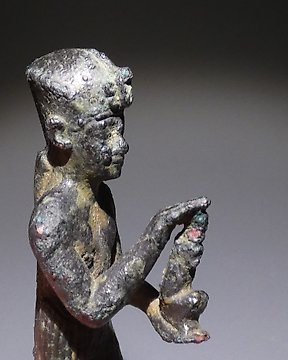
Altägyptisch Bronze Der Pharao befreit eine Figur, die Göttin Maat. 11 cm H. Spätzeit, 664 - 332 v. Chr. - 9 cm
Nr. 83550301

Nr. 83550301

Harpocrates emerging from lotus flower. Ex. Amherst Collection, 1900.
Egypt, Late Period, 664 – 332 BC.
Bronze.
17,2 cm height with stand and 13.3 cm Height without stand.
PUBLISHED:
- Egyptian Antiquities from the MacGregor, Hilton Price, Amherst, Meux & Carnarvon Collections. Spink & Son’s Galleries. Londres. 1924. p. 20.
IMPORTANT PROVENANCE:
- Old collection of William Tyssen-Amherst, 1st Baron Amherst of Hackney, England, 25th April 1835 – 16th January 1909. He became a noted bibliophile and collector, tapestries, antique furniture, other works of art and Egyptian artifacts. He was created 1st Baron Amherst of Hackney. He also became a patron of the young Howard Carter - the Egyptologist famous for discovering the tomb of Tutankhamun. When he got bored he spent time in the Egyptian room looking at the collection Amherst had accumulated over the years, sparking Howard’s fascination in things Egyptian.
- Old collection of Mary (May) Rothes Margaret Tyssen-Amherst, Lady William Cecil, 2nd Baroness Amherst of Hackney, England, 25th April 1857 - 21th Decembr 1919. Thirty-two of the Tombs of the Nobles at Aswan were uncovered in her excavations and for many years were known as the "Cecil Tombs".
- Egyptian Antiquities from the MacGregor, Hilton Price, Amherst, Meux & Carnarvon Collections. Spink & Son’s Galleries. Londres. 1924. p. 20.
- Exhibited in the “Museum” at Didlington Hall, Norfolk, with the Amherst collection.
- Old private collection, Paris, France, 1960 – 1970.
- Sold by descendants at a public auction, Paris, 2011.
- With Galerie Chenel, Paris, 2013, acquired from the above sale.
- ARL: S00048329.
In this way Harpocrates, the child Horus (was the child of Isis and Osiris), personifies the newborn sun each day, the first strength of the winter sun, and also the image of early vegetation. Egyptian statues represent the child Horus, pictured as a naked boy with his finger on his chin with the fingertip just below the lips of his mouth, a realization of the hieroglyph for "child".
Publications
- Egyptian Antiquities from the MacGregor, Hilton Price, Amherst, Meux & Carnarvon Collections. Spink & Son’s Galleries. London. 1924. p. 20.
- Coulon, Laurent (dir.). La Cachette de Karnak. Nouvelles perspectives sur les découvertes de Georges Legrain. Institut Français d’Archéologie Orientale. 2016. p. 181.
Notes:
- The piece includes authenticity certificate.
- The seller guarantees that he acquired this piece according to all national and international laws related to the ownership of cultural property. Provenance statement seen by Catawiki.
So kaufen Sie auf Catawiki
1. Etwas Besonderes entdecken
2. Höchstgebot abgeben
3. Sichere Zahlung durchführen